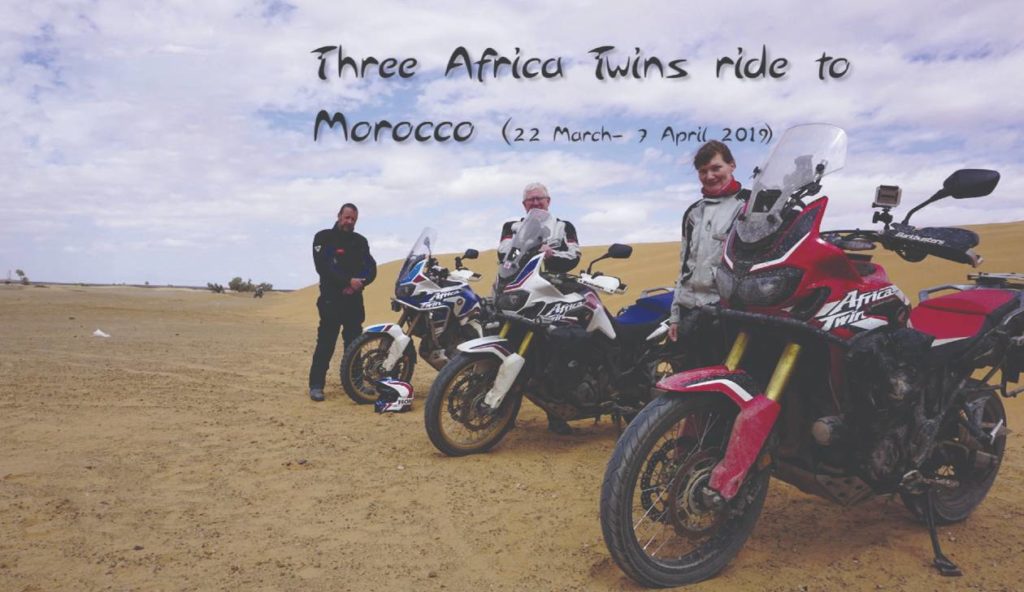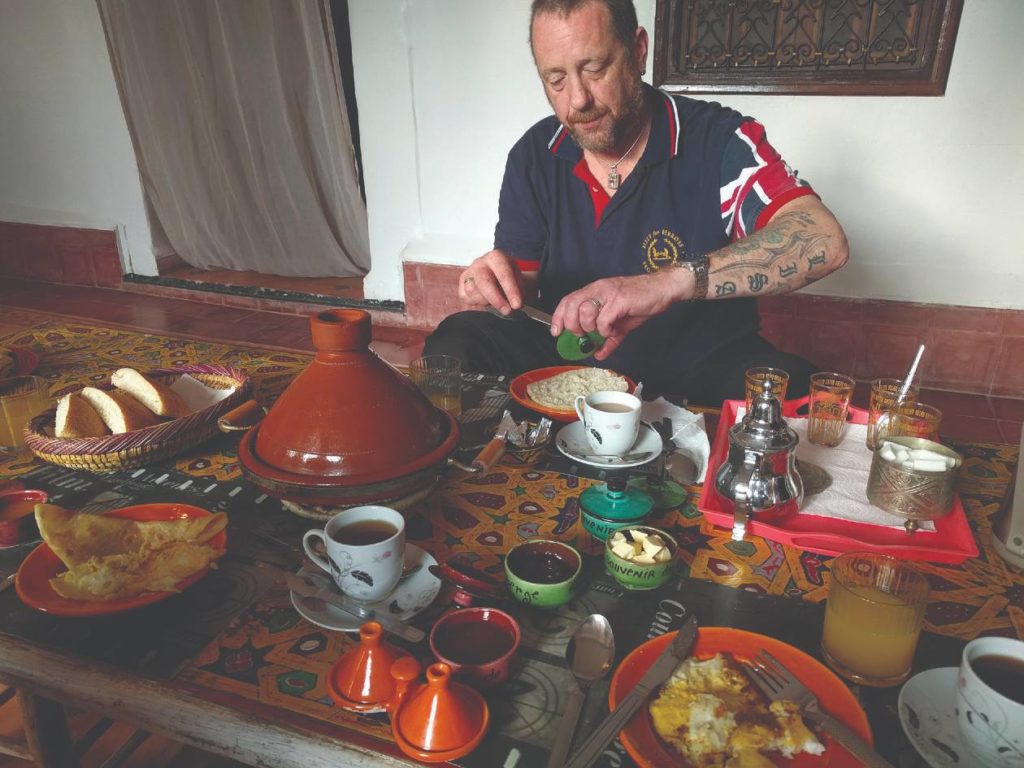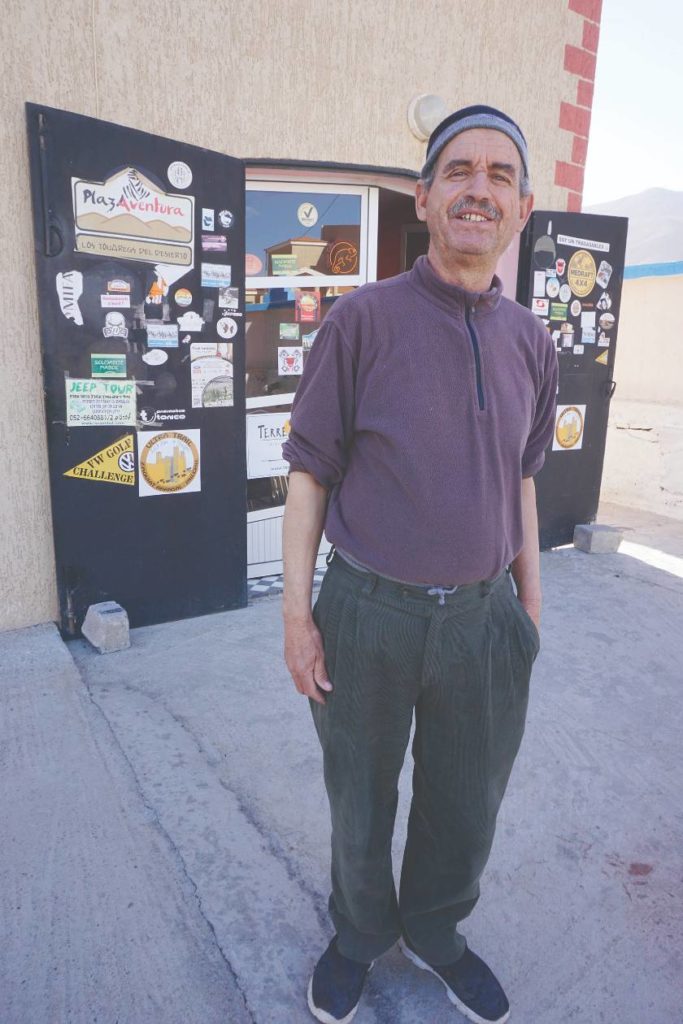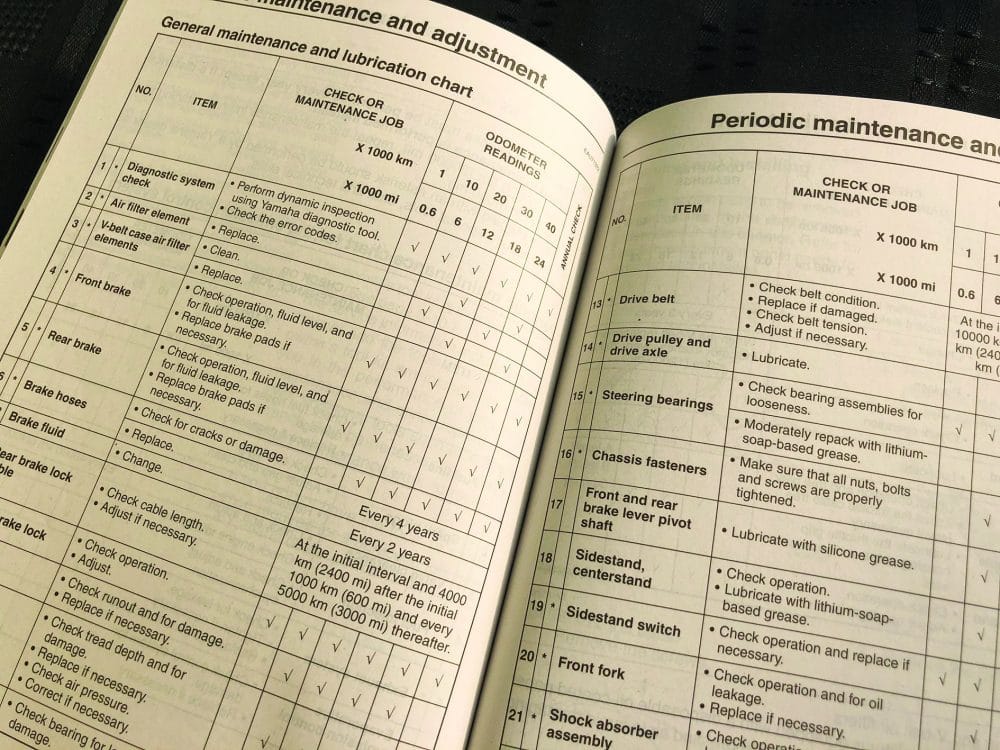How it all came about
As explained in the February issue 2021 our ultimate plan was a big trip to New Zealand to see friends with no time frame which was meant to have kicked off in 2020 until Covid struck. Here we relate the second of our preparation shakedown trips. The first was in 2018, to Eastern Europe and the Balkans (see Slipstream Feb/Mar issues 2021) and then in 2019, this trip to Morocco.
Six, Five, Four, Three….. Go!
Bike insurance – check. AA breakdown cover – check, not that either would be valid for most of our upcoming trip. In fact, due to timing and Brexit we’d also need green cards and international driving permits. The UK was due to leave the EU on 31st March 2019 and we were planning to be in Morocco a week before then, returning a week after. This made for some interesting conversations with our UK insurers, as they wanted us to contact them the week before when they would be able to confirm if a green card was needed. How they thought they would get them to us I don’t know, but I’m sure we weren’t going to be the only people travelling abroad at that time. The potential penalty for not having one could be confiscation of our bikes, so pretty serious stuff. Most people under a certain age wouldn’t have even heard of green cards, Brexit was going to bring even more complexity than needing a separate piece of paper alongside your insurance for Europe, but that’s another story.
Planning for the trip had started several months ago with a group of six on a mix of bikes. The route would take us from Portsmouth to Santander on the ferry, south through Spain, ferry to Morocco then head south. The ferry would leave on Friday afternoon and we’d be in Morocco by Monday lunchtime. Much like our previous Balkans trip, we did very little pre-booking to give us flexibility on the road.
Once in Morocco we’d head south past Casablanca and Marrakesh, through the Tazi n Test pass before turning eastwards towards Ouarzazate, north into the High Atlas mountains via the Todra Gorge to Imilchil, then south again into the Dades gorge on the piste. Next, we’d head to Merzouga to ride the Erg Chebbi sand dunes, before turning north and homewards, stopping in the blue city of Chefchaouen before the ferry back to Spain.
I’d met Chris Scott and bought his book Morocco Overland at a Horizons Overland event, and it was invaluable for planning, showing a number of pistes over the Atlas and High Atlas mountains, graded by difficulty and bike size, which was pretty important as none of us were experienced off road riders. I had a Garmin Montana which is great for off road routes so I loaded them all, marking by difficulty so we could decide when we were close. I mounted it next to my TomTom SatNav on the bike so they could be used side by side.
The routes were often remote, many miles from the nearest villages, no breakdown or emergency services out here, so we’d be on our own. I had bought a Garmin InReach Mini in anticipation of our big trip, which would attach to my jacket. This little gadget communicated via a direct satellite link and featured an SOS button hidden under a small flap. You didn’t want to hit this by accident as it would signal a control centre to start a rescue with local emergency services wherever you were in the world. A bit overkill for Morocco but a great backup.
Researching the paperwork we’d need, we found we would need specialist travel insurance that would cover us riding large adventure bikes off road. Most insurers will only cover a 125cc abroad and then on road only. Navigator Travel Insurance would cover us and included emergency repatriation should the worst happen. Next up was motorcycle insurance. None of our existing policies would cover us and neither would any we could take out in the UK. Insurance would be available at the port in Tanger Med and would be 3rd party only. Two of the group dropped out due to this, not wanting to risk a complete loss in the event of an accident, which was understandable. Another dropped out as he decided his bike wasn’t up to riding any pistes. We were down to three – Marc, Marije and I, all riding Africa Twins.
The journey from the UK to Tarifa where we planned to cross was uneventful, Marc winning the Orca quiz challenge on the ferry and a pleasant overnight stop in Frómista. All the bikes had new tyres, Marije and I opting for road tyres and Marc going for knobblies. After dinner in Tarifa we found out that no ferries would run the following day so we aimed for an early start to get to Algeciras for the ferry, which would take longer to cross. We turned up at 7:30am, got our tickets and joined the queue. The next ferry was cancelled, the following we went through and lined up only for it to be cancelled, so we had to go back to the pre-check queue to wait, only for that to be cancelled. It looked like they would only sail when they had enough vehicles to make it worthwhile. We chatted to the other bikers in the queue, one being Rob, a fixer for Russian oligarchs in the UK, who was on an original Africa Twin he’d rebuilt himself.
Finally the barrier went up and being at the front of the queue I shot through. Having been through and checked once already I didn’t even notice the raised hand of the customs officer. Marije came over the intercom. “Best come back, he looks really pissed off and he’s armed.” After circling the car park I backed up to the booth and sheepishly handed over my documents. He checked them, handed them back and smirked, “Now go.”
Once on the ferry we had our first taste of bureaucracy. Everyone had to complete a police form, queue up in a long line and once at the window the officials would take the details, stamp and return it. We had known this would happen so made sure we got in the queue quickly, as it wasn’t uncommon for it to take hours to process everyone, possibly even longer than the crossing. Off the ferry and as we rode towards a set of booths we were summoned aside to put the bikes through a giant x-ray machine, big enough to x-ray trucks. Once done, our universal translator Marije spoke to one of the port workers to find out where to go next.
It turned out the x-rays were for people leaving, we’d just paused to work out where to go next in exactly the wrong place! Once headed the right way we stopped again to have our paperwork processed. V5 ownership document, police slip from the ferry and passport details were all entered into the computer. Marc swore under his breath when he pulled his documents out. His original V5 was still on the copier at home and he only had the copy with him. In true comradery we wished him a good ride back to the UK, we’d send him pictures as we went. Miraculously the customs office accepted his copy and issued a temporary import slip which we’d need to hand back when we left the country.
The summer in Morocco can see temperatures north of forty Celsius, and the winters can be quite cold and wet. The best times to travel are early spring or early autumn and we’d chosen late March. As we headed to Marrakech we could see dark clouds on the horizon, then lightning, then torrential rain started. I asked Marc over the intercom if he wanted us to stop so he could put on waterproofs. “Too late, soaked through already,” came the reply. Marije and I had our Richa kit we’d used for the Balkans which kept us dry. It was pricey, but we were glad we’d invested in it.
I’d put a few places to stay in my SatNav, so we headed to the Palm Auberge on the south side of Marrakech, where the owner opened the gates so we could ride our bikes into the foyer. It was just big enough to get all three in and allow other guests to still walk through. After checking in and finding we could have food but no beer, I rode to a nearby supermarket to stock up, which was a good move as we wouldn’t find any more for days to come. Two pounds for a 330ml can, in case you’re wondering.
The rain continued all evening, the beer flowed, the tagine was excellent and Marc dried out.
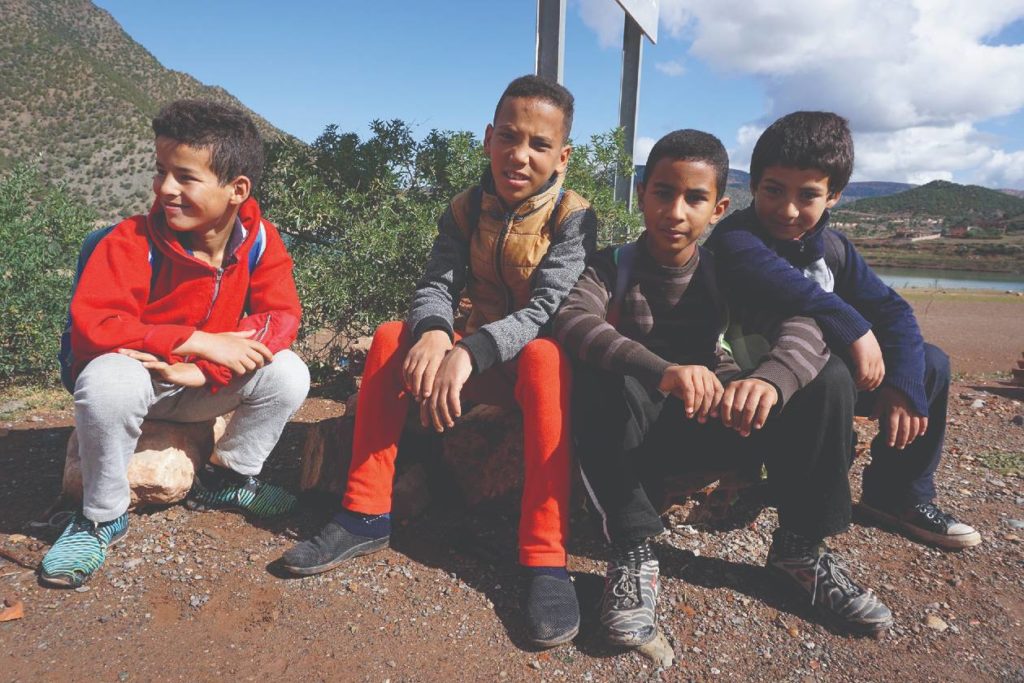
The Tizi n Test
The following morning the sun was shining, a great time for a ride through the Tizi n Test pass, described on the Dangerous Roads website as one of the most spectacular drives in the country. Not for the faint-hearted.
We stopped for fuel near a large open air car park that had dozens of 4×4’s parked in it for tourists to be driven up the pass. It also meant it was a tourist trap and we spent more time saying no to souvenir salesmen who surrounded us at the pumps than we did fuelling up.
Earlier on in the day we had stopped for a quick brew next to a lake, only to find we had stopped next to a school. After the children had surrounded us, asking questions and skilfully extracting every snack bar all three of us possessed, I had pulled back onto the road only to find I was on the wrong side when I came face to face with a local driver.
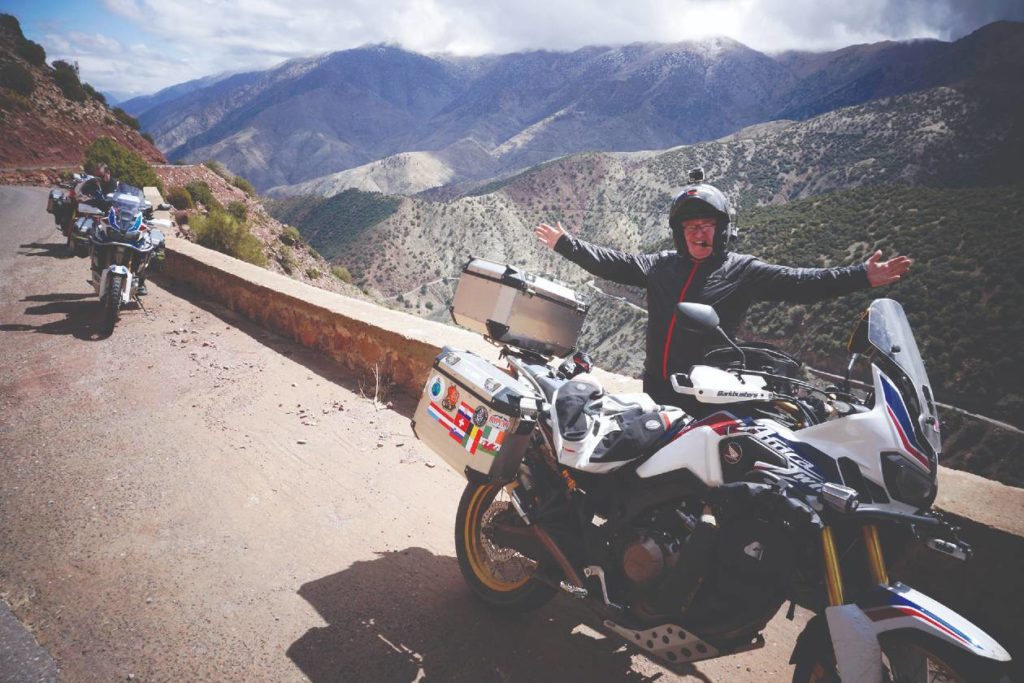
As we headed up the pass, I kept reminding myself to keep right, there are no road markings and the edges are weathered and worn. There are few barriers and the ones that exist are more likely to flip you into the valleys below than save you. The road twists and winds with regular switchbacks and little traffic and stunning views across the valleys – a truly spectacular route.
Nearing the top of the pass we hit the clouds and drizzle. Visibility dropped to a few metres and the road surface broke up, not yet having been repaired after a wet winter and freezing temperatures. Now I was riding in the middle of the road, sheer rock face on one side and what looked like a steep drop on the other.
This is when I found out that Moroccans don’t use their lights in these weather conditions. They do use their hazard lights which allows you to see something through the mist, but as I made out the yellow flashers ahead I realised it doesn’t help with working out which way they are facing. I moved to the right just in case, but fortunately the car was heading the same way as us so we just followed, giving it as much space as we could without losing him.
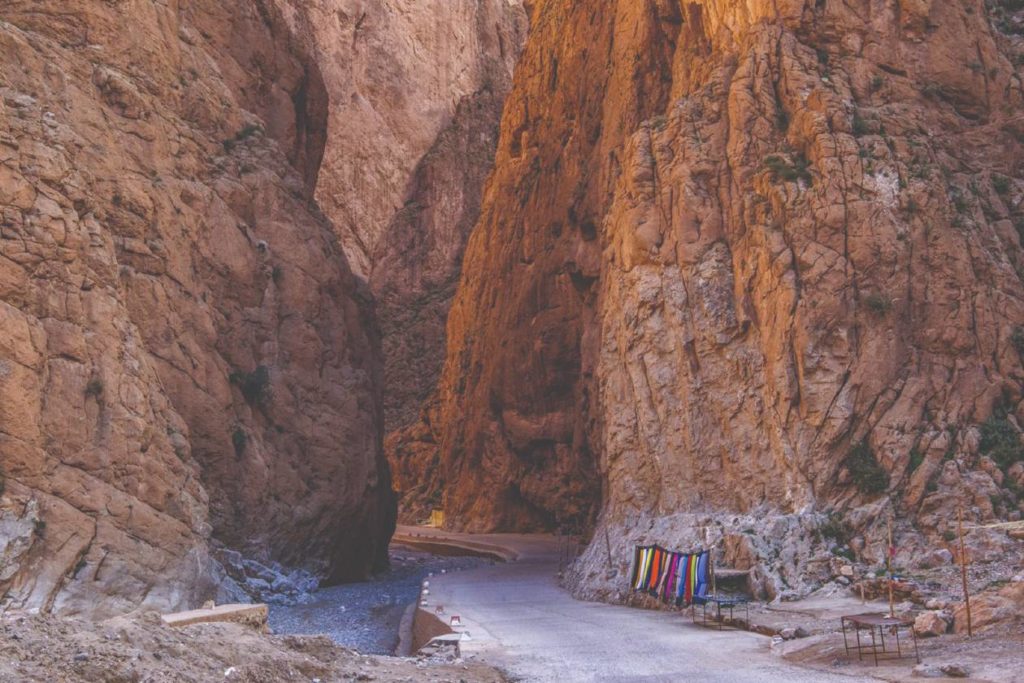
The clouds cleared and the road opened up a bit, the surface improved and the local we’d been following accelerated. The road down was as spectacular as the route up but instead of mountains ahead, in the distance we could see desert stretching for miles. We turned eastwards onto the N10 and we rode across seemingly endless desert, only slowing for camels crossing the road.
The Todra gorge gave us a stunning entry into the Atlas Mountains, with steep cliffs up to five hundred feet high either side of the canyon, and a river running through it. As you look up, the upper portions of the cliffs look golden where the sun reaches down to illuminate them. Alongside it, the road runs, twisting and turning as we ascend. The gorge runs for about twenty five miles and once we got higher it gets colder and the roads crumble. Kids run out at the sound of the bikes trying to high five all three of us. At first it’s fun but after a while I got nervous about running them over as they dart out, or losing my glove as they hang on to the fingers of it.
We encountered a couple of sections of road which had been washed out, resulting in forty foot long fords to traverse, leaving us covered in water and muck. We looked a state when we arrived in Imilchil and pulled into the impressive looking Auberge Chez Bassou. The front doors were covered in stickers from previous two and four wheeled adventurers. We hadn’t pre-booked, but the owner stood outside as if expecting us.
In the evening as we were drinking the last of our beers over dinner, an American couple and their college-aged son arrived in the darkness. They were due to stay with a Moroccan family another couple of hours drive through the mountains and asked if they were heading in the right direction, and if it was safe. The owner recommended they wait for daylight as the roads were unlit and animals ran wild.
The father looked at our beers, smiled and asked the owner “Can I get beer here if we stay, or is there a store?” to which the owner pointed out of town and said “Beer about three hours that way, but if you have any you’re welcome to drink it here”. We shared our last cans.
As we looked over the maps the owner came over, so we asked what was the piste down to the Dades gorge like. “On your bikes it’s fine, as long as it’s dry.” That was it, tomorrow the piste.
Damien Murray
First published in Slipstream May 2021

